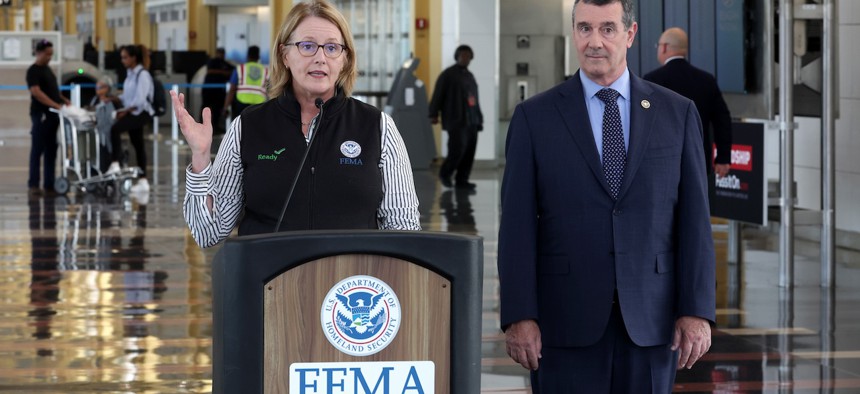Lawmakers debate the role of an overworked and under-resourced FEMA
Despite some hiring success, FEMA is taking on more tasks while operating at 65% capacity.
Amid growing recognition the Federal Emergency Management Agency is struggling to keep pace with its new, permanent state of response, some lawmakers are questioning whether the organization has bitten off more than it can chew.
FEMA employees in recent years have deployed to natural disaster sites, wildfires, the U.S.-Mexico border, in support of the resettling of Afghan evacuees and for pandemic assistance, all while dealing with a staff 6,000 workers short of the agency’s goal. Employees have warned they are fatigued due to the lack of downtime between deployments and said burnout is spiking as they no longer experience a true offseason.
Some Republicans on the House Transportation and Infrastructure Committee’s panel on Emergency Management said on Tuesday perhaps FEMA, in part due to congressional mandates, has taken on too much responsibility. They suggested FEMA has engaged in “mission creep,” particularly as it relates to the emergency food and shelter assistance it has provided for migrants arriving at the border.
“FEMA can’t be all things to all people,” said Rep. Scott Perry, R-Pa., who chaired the hearing. “We have to get a handle on the proper role of FEMA and ensure FEMA’s internal controls reduce fraud and misuse of taxpayer funds.”
FEMA Administrator Deanne Criswell noted her agency took on the responsibility only after a 2019 law tasked it with doing so. At the peak of FEMA’s deployments to the southwest, she said, just 250 agency personnel were working at the border. Today, that number is down to 50 employees and Criswell added most of those deployments are reimbursed by other agencies.
Rep. Derrick Van Orden, R-Wis., said even that reduced figure was too high, noting there are still acute disasters to which FEMA must respond.
“My point is this: if there is even one single member of FEMA working on the border processing illegal aliens coming into the country—our Hawaiian brothers and sisters are without homes—that's one too many,” Van Orden said.
Chris Currie, a director at the Government Accountability Office for Homeland Security and Justice, told lawmakers staffing shortages have forced FEMA to function at 65% of its operating capacity. The biggest impact, he said, was on the long-term recovery impacts, with FEMA’s ongoing projects dating back to Hurricane Katrina response. In 2017, he added, FEMA deployed 3,300 staff and reservists per day, whereas today that number has more than doubled to 7,000.
“According to FEMA itself, it recognizes these challenges, the shortages, have led to burnout and attrition issues,” Currie said. “And you know, part of this, according to them, was COVID-19 and the never-ending disaster season that they now face.”
FEMA reservists have told Government Executive that new hires were receiving insufficient training before deployment and some employees were working 12-hour days for a month straight. The agency has frequently tapped volunteers throughout the Homeland Security Department and elsewhere in government to help supplement its efforts.
Perry said Congress is in part to blame by adding more to FEMA’s already crowded plate.
“They're trying to get the job done,” the chairman said to Criswell of her workforce. “You don't have the resources. And quite honestly, I don't think Congress has helped you very much by throwing more at you.”
Currie said burnout at FEMA has increased since the pandemic and recruiting remains a challenge since most of its staff are reservists who only work part of the year. He added the benefit for those employees was frequently that they had months of break in between deployment, but increasingly the workers—particularly those with specialized skills—are being sent from one disaster to the next without any time off. He proposed a different system in which FEMA reservists serve more like the National Guard, wherein they regularly engage in training while not actively deployed.
Criswell said a training program like Currie proposed would allow the agency to ensure better skill proficiency within the workforce, improve retention and create clearer career paths. She added she was optimistic FEMA is better retaining its part-time workforce after Congress passed the Civilian Reservist Emergency Workforce Act to provide those employees who leave their day jobs to address disasters with the same protections as members of the armed forces deployed to active duty. She also said recruitment bonuses are helping to bring in more employees, as FEMA has been regularly onboarding new personnel every two weeks.
While FEMA remains well short of its staffing goals, it has added thousands of employees to its rolls in recent years—mostly within its reservist cadre.
“We're continuing to see this, so those types of legislation and new program changes that we have made will increase the most important part of our workforce, which is our reservist workforce,” the administrator said. “They are the ones that go out to each of these disasters to support them. We'll continue to look for additional ways that we can enhance that level of recruitment, as well as retention.”




